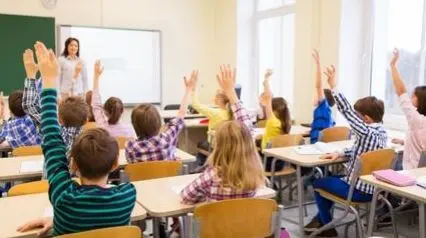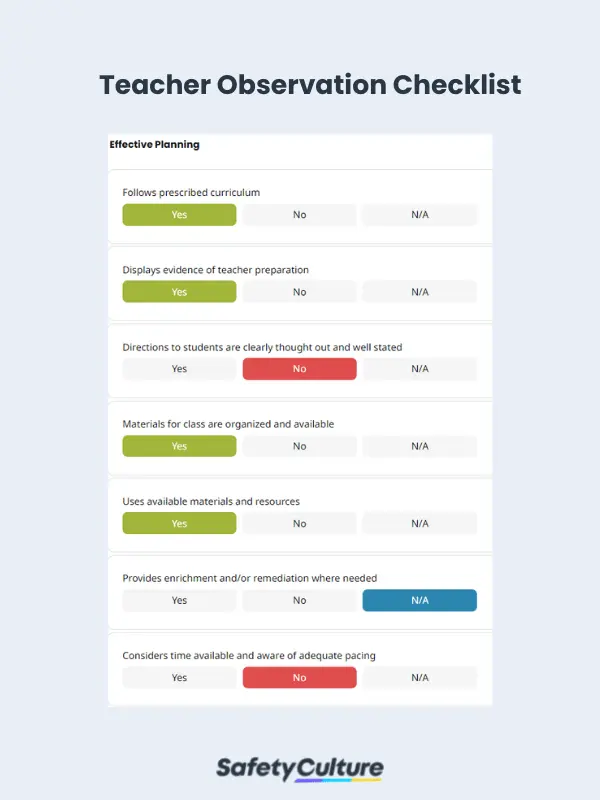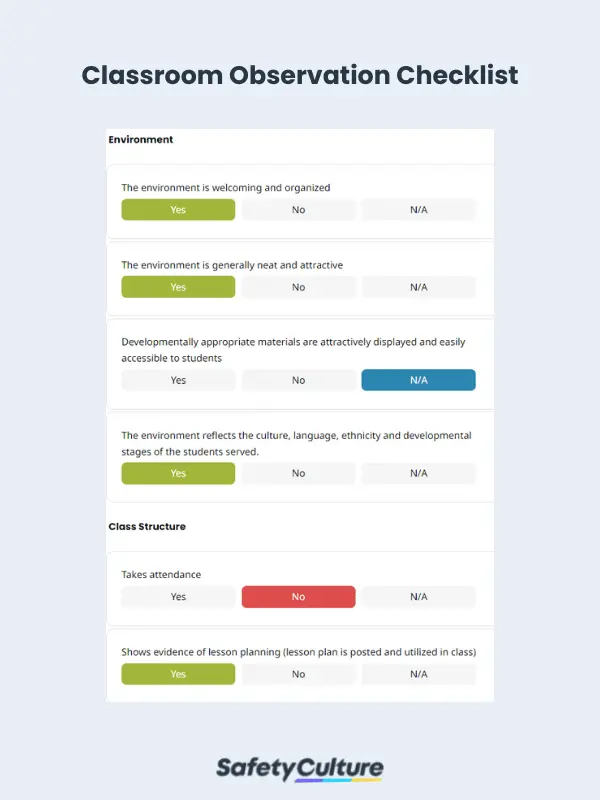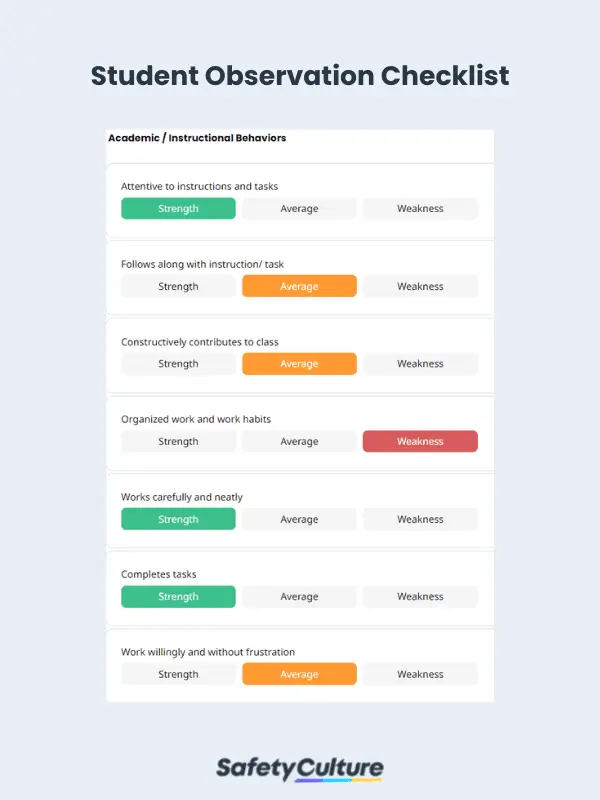What is an Observation Checklist?
An observation checklist is a tool for class observations, listing items and behaviors to be evaluated for proper assessment. A teacher and classroom observation checklist helps an observer identify skill gaps and problem areas to further improve teaching strategies, classroom settings, and student learning development. Observation checklists are often prepared by the observer, the teacher, or both of them. They can also be pre-existing and readily available templates that document general observation points to keep an eye on.
3 Types of Observation Checklists and What to Observe
Teacher Observation
Teacher observation is conducted to evaluate the effectiveness of teaching strategies, identify areas for improvement, and ultimately foster a culture of continuous professional development and improvement. A teacher observation checklist is used by school administrators to facilitate this, and it includes observing the following key areas:
- Effective Planning – This encompasses the preparedness of the instructor in the subject matter. (e.g Are assignments and group work planned according to instructional needs? Does the instructor provide clearly thought out and stated directions? Are materials available and well organized?)
- Teaching Techniques – This refers to the approach and delivery of the instructor to the subject matter. (e.g Does the instructor: Make clear and practical demonstrations? Utilize guides and other available materials related to the lesson? Adjust their teaching method in accordance with student abilities?)
- Student/ Teacher Relationships – This pertains to how the instructor interacts with their students academically. (e.g Does the instructor use positive statements to students? Does he/ she graciously accept less than “right” responses with slow students? Does he/ she work to maintain a friendly and respectful teacher-student relationship with his/ her pupils?)
Classroom Observation
A classroom observation checklist is a tool used by school administrators to ensure that a positive and conducive learning environment is provided for the students. What should we look for when observing a classroom?
Here are the key areas to check on when performing a classroom observation:
- The classroom is neat, welcoming, and an organized learning environment
- Developmentally appropriate materials are displayed and accessible to students
- The classroom reflects the culture, language, ethnicity, and developmental stages of the students
- Attendance is taken
- There is a lesson plan used
- The previous day’s course content is reviewed
- The course content covered is reviewed
- Job chart is visible and rotate “helper” roles for students (e.g room cleaning, line leader etc)
- There are non-lecture learning activities (i.e. small group discussion, student-led activities)
- There is class discussion and students are engaged and active
- The learning experiences appropriate to the level of learning
Student Observation
A student observation checklist is used by teachers to perform an individual or group evaluation on students regarding their behaviors and interactions within the classroom. Observation checks allow teachers to examine and adjust their teaching practices to cater to the learning needs of their students and determine ways to correct disruptive behaviors (if any).
Key student observations points are:
- Academic / Instructional Behaviors – This checks for the student’s working habits and organizational skills. (e.g Does the student work carefully and neatly? Does he/ she follow along with instructions and tasks? Is he/ she attentive to instructions and tasks?)
- Social Behaviors – This refers to the interaction of the student with the people they’re surrounded within the school (including peers and adults). (e.g Is the student friendly and respectful towards adults and his/ her peers? Does he/ she interact appropriately with peers in an academic setting?)
- General Behavior and Conduct – This area pertains to the student’s overall behavior. (e.g Does the student engage in disruptive behaviors in class? How is his/ her attention span? What about his/ her activity level?)
How to Use the Observation Checklist
The inclusion of the checklist will depend on its primary purpose, on the type of the observation checklist to be used, and on the kind of observation to be conducted. For observation checklists that focus on education and behavior, it is best to utilize them while physically witnessing the setup and inputting details as soon as they are observed.
Steps to Using the Observation Checklist
For effective use of an observation checklist, follow these steps:
- Factor the relevant areas – Ask the right questions per individual/group to be observed by breaking down essential items for each of them. The teacher observation template can include subjects such as effective planning, teaching techniques, and student/teacher relationships. A general classroom observation checklist, meanwhile, studies the environment, class structure, methods, teacher/student interactions, and content.
- Customize according to your specific needs – Since there are different factors to be considered in creating or using an observation checklist, modify ready-made checklists to best suit your needs.
- Pick the best corresponding choices – Answers to each item can be a range of Yes, No, N/A, a variation of strong, average, weak, or any other choices that would best correspond to your set questions.
- Include general observations – Add general notes or recommendations for every observation conducted. This can be used as a way to highlight any glaring weaknesses and areas for improvement, or as a feature to reinforce positive comments.
- Sign off with a digital signature – Complete the use of observation checklists by adding the name and signature of the evaluator, teacher, or instructor.
FAQs about Observation Checklists
Classroom observation is the process in which a teacher’s performance is observed in their classroom or learning environment to measure behavior and mastery as part of a formal job performance evaluation or for providing relevant feedback to make improvements in their teaching techniques. Depending on the purpose of the classroom observation, it can be facilitated by a school administrator, a specialist, teachers’ colleagues or peers, or a coach. Classroom observations can also be conducted to help teachers and researchers identify any inequities and any instructional problems for the betterment of the students’ learning experience.
A student observation is a technique used for understanding a student’s academic and behavioral performance. This allows both the teacher and student to identify what areas he/she can improve on. Observations can be recorded any time during the school day.
The advantage of using an observation checklist and teacher evaluation forms is that it is a great guide in gathering useful information that can provide more objective insight on what can be improved in teaching methods, classroom setup, and student learning.
Aside from providing users with a structured format during class observations, observation checklists also increase the credibility of the result. A comprehensive observation checklist is an excellent tool for data collection, helps ensure consistency throughout, promotes objectivity by proving clear criteria of how to do the observation, and sets the focus and scope of the activity, making it more intentional.





